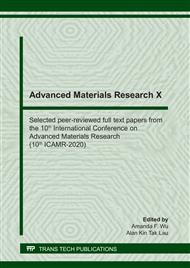[1]
Hiroshi Nemoto, Shuya Hirano, Hironobu Nishi, Shigeyuki Date: Experimental verification on improvement of properties of fresh concrete using stiffening inhibitor, Vol.39, No.1, pp.1261-1266,2017.7.
Google Scholar
[2]
Hiroshi Nemoto, Shuya Hirano, Shigeyuki Date, Shinichiro Hashimoto: Admixture to reduce stiffening in concrete, Concrete Engineering, Vol.57, No.1, pp.16-19, 2019.1.
Google Scholar
[3]
Koji Kikukawa: Research on viscosity formula of mortar and concrete, Proceedings of Japan Society of Civil Engineers, No.414, pp.109-118, 1990.2.
Google Scholar
[4]
Koji Koda, Hiroshi Nemoto, Akira Toda, Takashi Nagahama, Takashi Oshio, Akira Akamatsu: Examination of stiffening evaluation method for high-fluidity concrete applied in a narrow construction environment, Japan Society of Civil Engineers 73rd Annual Lecture , V-415, pp.829-830, 2018.8.
Google Scholar
[5]
Tattersasll G.H. and Banfill P.F.G. The Rheology of Fresh Concrete,Pitman,London,(1983).
Google Scholar
[6]
Tattersasll G.H. and Bloomer S.J. Further Development of the Two-Point Test for Workability and Extension of its Range, Magazine of Concrete Research,Vol.31,pp.202-210,(1979).
DOI: 10.1680/macr.1979.31.109.202
Google Scholar
[7]
Ferraris,C. and Brower,L.(eds.): Comparison of Concrete Rheometers:International Test at MB(Cleveland OH,USA)in May 2003,NISTIR7154,(2004).
DOI: 10.6028/nist.ir.7154
Google Scholar
[8]
Mishima Nao: Research on thixotropy of fresh concrete, Concrete engineering, Vol.49.No.3, pp.43-49,2011.3.
Google Scholar
[9]
Shuya Hirano, Yui Nishi: Experimental study on evaluation of handling of fresh concrete by vane shear test, Annual report of concrete engineering, Vol.40, No.1, pp.1107-1112, 2018.6.
Google Scholar
[10]
Toru Shibata: Study on Vane Shear Strength of Clay, Proceedings of Japan Society of Civil Engineers, No.138, pp.39-48, 1967.2.
DOI: 10.2208/jscej1949.1967.138_39
Google Scholar
[11]
Hiroshi Nemoto, Shinji Urano, Mizumoto Takemura: Mixing examination of high-fluidity concrete applied to the reversing method, Abstracts of the 68th Annual Conference of the Japan Society of Civil Engineers, Section IV, pp.1141-1142, (2013).
Google Scholar
[12]
Akabuchi Iori, Inami Sakiko, Yamada Yoshitomo and Hosokawa Yoshifumi: Fundamental Study on Viscosity Change of Cement Paste by Aggregation and Hydration, Cement and Concrete Papers, Vol.66, pp.653-660,(2012).
DOI: 10.14250/cement.66.653
Google Scholar
[13]
Shinichiro Hashimoto, Yukio Emoto, Shinnori Hashimoto, Shigeyuki Date: Effect of Slump Loss on Concrete Workability, Proceedings of Concrete Engineering, Vol.32, No.1, pp.1295-1300 , 2010.6.
Google Scholar


